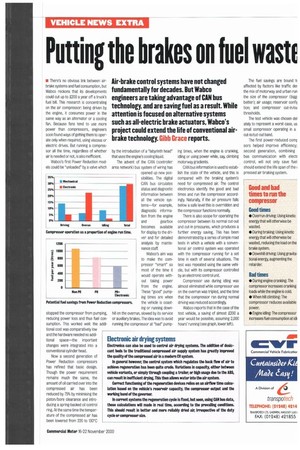Putting the brakes on fuel wastE
Page 17

If you've noticed an error in this article please click here to report it so we can fix it.
• There's no obvious link between airbrake systems and fuel consumption, but Wabco reckons that its developments could cut up to £200 a year off a truck's fuel bill. This research is concentrating on the air compressor: being driven by the engine, it consumes power in the same way as an alternator or a cooling fan. Because fans tend to use more power than compressors, engineers soon found ways of getting them to operate only when required, using viscous or electric drives. But running a compressor all the time, regardless of whether air is needed or not, is also inefficient.
Wabco's first Power Reduction models could be "unloaded* by a valve which stopped the compressor from pumping, reducing power loss and thus fuel consumption. This worked well: the addi tional cost was comparatively low and the hardware needed no additional space—the important changes were integrated into a conventional cylinder head.
Now a second generation of Power Reduction compressors has refined that basic design. Though the power requirement remains much the same, the amount of oil carried over into the compressed air has been reduced by 75% by minimising the piston/bore clearance and introducing a spring-backed oil control ring. At the same time the temperature of the compressed air has been lowered from 220 to 130°C by the introduction of a "labyrinth head" that uses the engine 's cooling liquid.
The advent of the CAN (controller area network) bus system of wiring has opened up new possibilities. The digital CAN bus circulates status and diagnostic information between all the vehicle systems—for example, diagnostic information from the engine and gearbox becomes available for display to the driver and for detailed analysis by maintenance staff.
Wabco's aim was to make the compressor "smart' so most of the time it would operate without taking power from the engine.
Those "good" pumping times are when the vehicle is coasting or running downhill on the overrun, slowed by its service or auxiliary brakes. The idea was to avoid running the compressor at "bad" pump
Electronic
ing times, when the engine is cranking, idling or using power while, say, climbing motorway gradients.
CAN bus information is used to establish the state of the vehicle, and this is compared with the braking system's need for compressed air. The control electronics identify the good and bad times and run the compressor accordingly. Naturally, if the air pressure falls below a safe level this is overridden and the compressor functions normally.
There is also scope for operating the compressor between its normal cut-out and cut-in pressures, which produces a further energy saving. This has been demonstrated by a series of simple road tests in which a vehicle with a conventional air control system was operated with the compressor running for a set time in each of several situations. The test was repeated using the same vehicle, but with its compressor controlled by an electronic control unit.
Compressor use during idling was almost eliminated while compressor use on the overrun was tripled, and the time that the compressor ran during normal driving was reduced accordingly.
Wabco reports that in the case of the test vehicle, a saving of almost £200 a year would be possible, assuming 2,000 hours' running (see graph, lower left). The fuel savings are bound ti affected by factors like traffic der the mix of motorway and urban run the size of the compressor (bigg better); air usage; reservoir confq tion; and compressor cut-in/cu thresholds.
The test vehicle was chosen del ately to represent a worst case, us small compressor operating in a cut-in/cut-out band.
The first power-reduced corn sors helped improve efficiency; second generation, combining bus communication with electi control, will not only save fuel should extend the life span of the pressed air braking system.








































































































